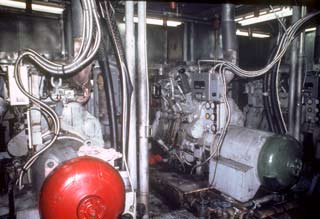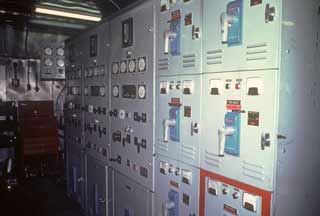Power, water, and you know what
 A look at the Caterpillar diesel generators in the power plant as they appeared in 1977. The "official" sea level rating was 250 kw but because there is less oxygen available at this altitude, they were only good for perhaps 180-190 kw here. Of course we needed nowhere near that much power. During the winter we kept lots of lights and electric heaters on so that there was enough load on the engines (130-140 kw or so) for them to perform efficiently and stay on frequency, A look at the Caterpillar diesel generators in the power plant as they appeared in 1977. The "official" sea level rating was 250 kw but because there is less oxygen available at this altitude, they were only good for perhaps 180-190 kw here. Of course we needed nowhere near that much power. During the winter we kept lots of lights and electric heaters on so that there was enough load on the engines (130-140 kw or so) for them to perform efficiently and stay on frequency, The alternators (the paint colored "electrical" ends) on these units were replaced in the early 1980's with newer more efficient models, but since the diesels were still the same, the available power output didn't change by much. In 1989-91 the generators were replaced with much larger new machines, and later upgrades mean that the plant routinely puts out 380 kw which is still not enough nowadays. Construction on the new power plant arch and structure for the elevated station began in the 99-00 summer, with interior work continuing through the winter. The new plant has 3 3512 machines rated for 1025 kw at sea level (750kw at altitude) at 277/480v...almost McMurdo size, plus a fourth "peaking unit," a 3412 good for 250-300 kw at altitude. The new plant went on line in January 2001. At that time, a temporary feeder was run to the existing plant (connecting where #1 engine does now) and a heat exchanger was installed, all this to backfeed power and heat to the existing station. Since I'm more than a little bit proud of my design of the 1989-92 upgrade of the current power plant, as well as the way it turned out, here are a couple of my Caterpillar hero shots and a few more technical details and more recent photos. Have a look, by February 2001 this will all be history!  Back to 1977, here's the switchgear end of the plant in the old days. The breaker marked in red is the feeder to the summer/ emergency camp. The old construction camp was not interconnected with the dome, so when we arrived we expected to operate two power plants during the summer. After the fire, one of the new projects included running a cable between here and the relocated summer camp power plant so that we could power that place from here. We also successfully tested backfeeding the dome from one of the 100 kw summer camp generators. Back to 1977, here's the switchgear end of the plant in the old days. The breaker marked in red is the feeder to the summer/ emergency camp. The old construction camp was not interconnected with the dome, so when we arrived we expected to operate two power plants during the summer. After the fire, one of the new projects included running a cable between here and the relocated summer camp power plant so that we could power that place from here. We also successfully tested backfeeding the dome from one of the 100 kw summer camp generators.
There were a few control circuits in the switchgear that did not seem to work properly. One of these had automatically decided to dump the CO2 bottles the year before. Part of the 1989 upgrade was to make these gremlins go away...but the proprietary circuit boards in the regulators and governors will never make this stuff foolproof in the middle of the winter when the vendor rep can't make it in! 
Steam rises out of the snow melter as we add to our water supply. In summer the snow melter (heated with waste heat from the generators) was rather greedy, but during the winter 1 or 2 buckets per day would suffice. A couple of years later a larger replacement snow melter was installed on top of this one, and nowadays there is a well that makes these outdoor trips unnecessary (hot water is pumped down into a hole in the ice, and the heat from the water melts more which can be pumped back up for station use)..  The station utilities were distributed in a corrugated steel tunnel, the utilidor, which extended underneath the original station buildings. Here's one of the manhole access points, and Bill Koleto and Ken Gibson are checking things out.  The view down below. At left, the cable tray and the hot glycol lines which enabled the station to be heated using waste heat from the generators. The heat traced water and sewer lines are on the right. In 1977 the utilidor was plumb, straight and level as it was when the Seabees laid it out during construction, and the sewage flowed by gravity to the end of the tunnel and straight down into a pit to freeze into what sometimes was referred to as a chocolate popsicle. [Trivia time, what is REALLY at the end of the utilidor??] No one had any idea back then if or when the original sewage outfall would ever fill up...but it did. By 1979-80 the downstream end of the utilidor had a significant downward slope, and the sewage bulb filled up, flooding the downstream end of the utilidor with you know what which a good friend of mine as a GFA had to chip out. The first of several lift stations was installed to get the sewage to new pits via above-snow piping. The lift station was a real maintenance headache from the beginning; the earliest unit couldn't deal with the tampons used by the rapidly growing female population. In 96-97 CRREL carved a new utilidor tunnel for the sewer directly out of the snow, eliminating the need for the lift station, and more recently the dome utilidor tunnel systems were abandoned and replaced by the new station's ice tunnels, but I can attest that the distinctive and unforgettable utilidor smell hasn't changed.
The view down below. At left, the cable tray and the hot glycol lines which enabled the station to be heated using waste heat from the generators. The heat traced water and sewer lines are on the right. In 1977 the utilidor was plumb, straight and level as it was when the Seabees laid it out during construction, and the sewage flowed by gravity to the end of the tunnel and straight down into a pit to freeze into what sometimes was referred to as a chocolate popsicle. [Trivia time, what is REALLY at the end of the utilidor??] No one had any idea back then if or when the original sewage outfall would ever fill up...but it did. By 1979-80 the downstream end of the utilidor had a significant downward slope, and the sewage bulb filled up, flooding the downstream end of the utilidor with you know what which a good friend of mine as a GFA had to chip out. The first of several lift stations was installed to get the sewage to new pits via above-snow piping. The lift station was a real maintenance headache from the beginning; the earliest unit couldn't deal with the tampons used by the rapidly growing female population. In 96-97 CRREL carved a new utilidor tunnel for the sewer directly out of the snow, eliminating the need for the lift station, and more recently the dome utilidor tunnel systems were abandoned and replaced by the new station's ice tunnels, but I can attest that the distinctive and unforgettable utilidor smell hasn't changed. |